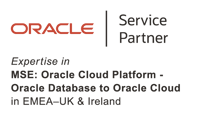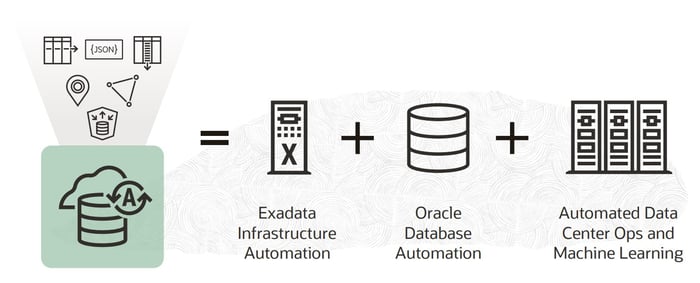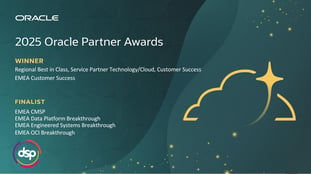
Oracle Autonomous Database Technical Overview
A fully autonomous, mission-critical Oracle database service that runs all workloads and reduces operational costs.
Contents


-EMEA-UKIE-clr-rgb.png?width=200&height=146&name=o-service-prtnr-OracleCloudPlatDataMgmtAuto(ADW-ATP)-EMEA-UKIE-clr-rgb.png)

What is Autonomous Database?
Autonomous Database is a converged database that supports both analytical and transactional workloads. Machine learning is used to automatically scale, optimise, patch, and secure all workloads to ensure the highest standards of service availability, security, and efficiency. It is built on Oracle database and Oracle Exadata for simpler and less expensive cloud migration. Autonomous Database is accessible on the public cloud with shared and dedicated infrastructure and on-premises with Exadata Cloud@Customer.
- Self-driving: Provides highly available, workload-optimised databases. Utilises automated configuration settings, reduces the amount of tuning, and scales compute resources as required.
- Self-securing: Prevents unauthorised access, safeguards sensitive and regulated data, and automatically patches your database for security flaws.
- Self-repairing: Identifies and guards against user and system errors, and provides failover to backup databases with no data loss.

Foundation
Oracle Database Enterprise Edition, Exadata Database Machine, and Oracle Cloud Infrastructure serve as the foundation for Autonomous Database. It incorporates and automates many advanced Oracle database technologies, such as:
-
Active Data Guard for database-aware disaster recovery
-
Database Vault for role separation
-
Online operations for schema changes
-
Transparent Database Encryption for data protection
-
Database In-Memory for high performance
-
Real Application Clusters for scale-out, failover, and online patching
Exadata Database Machine allows the database engine to offload critical functions to Exadata storage, and execute them with minimal data movement. These offloaded functions include a variety of critical operations, like filtering for changed blocks during incremental backup and running SQL fragments during parallel analytic operations.
Autonomous Database use cases
Oracle Autonomous Database provides the following services:
Autonomous Database for Analytics and Data Warehousing (ADW) is a completely autonomous, mission-critical database service designed for analytic workloads such as data marts, data warehouses, and data lakes. It is pre-configured with columnar data storage and is optimised for workloads that demand large joins. This helps to accelerate the entire analytics lifecycle, from data extraction, loading, and transformation to running sophisticated reports, predictions, and machine learning. By eliminating human management and errors, operational expenses are reduced. Data analysts, data scientists, and business analysts can find business insights quickly, easily, and affordably using data of any size and type.
Autonomous Database for Transaction Processing (ATP) is a mission-critical database service optimised for transaction processing and mixed workloads, including OLTP, batch, and IoT. It is preconfigured for row format compression and data caching to improve the speed and business metrics of Oracle, custom, and ISV applications. Operational costs are reduced by eliminating human errors, and application developers and DBAs can rapidly and affordably build, migrate, and deploy applications.
Autonomous Database Deployment Options
Autonomous Database services provide a variety of deployment possibilities for the lowest possible expense, operational control, and isolation. Oracle takes full responsibility for all aspects of service operation whether Autonomous Database is deployed on shared or dedicated Exadata infrastructure. Customers with shared Exadata Infrastructure have the smallest minimum commitment, whereas customers with dedicated Exadata Infrastructure have greater control over infrastructure operations. As detailed below, each of these offerings offers significant benefits.
Shared:
Customers who choose this deployment option get the advantages of complete data and system isolation while also sharing infrastructure with other clients. The minimal commitment for the shared infrastructure deployment option is just one hour, one OCPU, and one terabyte of database storage. It can be fully online and immediately scaled in terms of CPU and/or storage, allowing users to only pay for the resources they use. Shared infrastructure is great for departmental apps, line of business applications, or data marts. It also works well as a testing ground for data scientists and developers.
Dedicated:
Customers have their own dedicated Exadata infrastructure in the Oracle Cloud, allowing them access to a private database cloud within the Oracle public cloud. Oracle Autonomous Database on Dedicated Infrastructure operates within a hardware-enforced virtual cloud network, providing the most isolation from other users. Users can easily set up container databases on their dedicated infrastructure. These can contain one or more pluggable databases.
The dedicated infrastructure allows customers to tailor the operational rules used to manage the provisioning of a new database, the timing of updates, the availability, and the density of databases operating on the infrastructure. Having control over upgrade timings and database versions is especially important for applications sensitive to database version and release differences. Although customers can customise these operational policies, all operations are still fully automated by Oracle.
Autonomous Database on Exadata Cloud@Customer:
Many businesses are unable to readily migrate to the public cloud because of challenges related to the regulatory nature of their data, data residency laws requiring data to remain in its nation of origin, and the complexities of systems entanglement present in enterprise architectures. To mitigate these challenges while providing customers with the benefits of cloud self-service and a pay-per-use financial model, Oracle Exadata Cloud@Customer, brings the cloud to customers who cannot move easily to the public cloud.
Self-service data management
Self-service tools provide a straightforward, powerful environment for loading data and collaborating on it. With drag-and-drop capabilities, business and data analysts can simply load and transform data, generate business models, rapidly find anomalies, outliers, and hidden patterns, and comprehend data dependencies and the impact of changes.
Machine learning
Using scalable and optimised in-database algorithms, data scientists can create and deploy machine learning models in the database. Oracle Machine Learning enhances the creation of machine learning models for data scientists by removing the need to move data to specialised machine learning systems.
Graph analytics
Autonomous Database contains graph feature support for representing and managing complex data relationships. Data scientists and developers can use graph analytics to perform pattern detection, classification, and statistical analysis for greater context.
Spatial analytics
The spatial features apply to all types of applications, spatial workloads, and datasets, as well as the most challenging large-scale location intelligence and geospatial applications.
Low code app dev (Oracle APEX)
Oracle Application Express (APEX) is a low-code development platform that allows you to create scalable, secure enterprise applications with industry-leading features that can be deployed anywhere.
Data protection and security
Autonomous Database includes database security and privacy features such as identifying and masking sensitive data, issuing warnings on risky users and configurations, auditing critical database activities, and detecting suspicious attempts to access data.
Database cloning
Autonomous Database allows users to create a point-in-time copy of the database for purposes such as testing, development, or analytics, which can be refreshed to capture the most recent changes.
Automatic Updates
All software and underlying components in an autonomous database with shared infrastructure are immediately upgraded to the most recent versions. Oracle executes all updates immediately without interruption.
Rolling upgrades & application continuity
Workloads with stringent application continuity requirements are moved from one cluster node to another without interfering with applications or users. Moving sessions across cluster nodes while operations are in progress is an example of application continuity. Transactions can frequently continue processing after switching nodes without losing session information.
Automation controls
Dedicated Infrastructure enables customers to manage software versions, patching schedules, and database density for complex and mission-critical database applications. It also offers customers more control over the staging of Oracle software versions and patch levels from pre-production to production deployment. Customers can separate development, test, and production environments so that each is updated separately using a trust-and-verify model that enables validation of updates in pre-production environments before autonomous operations apply those updates to mission-critical production environments.
Service health dashboard
The Service Health Dashboard, which displays the state of all OCI services, including Oracle Autonomous Database services, allows customers to view system health, availability, and maintenance.
Fault detection & resolution
Faults in any computer system, including hardware failures and programme errors, can and do occur. Autonomous Databases are constantly monitored for the complete range of potential faults, and resolution is launched automatically in reaction.
Autonomous Database operates on redundant Exadata hardware that can withstand hardware failures without disrupting service. Oracle's Cloud Operations team sends a hardware technician to address hardware failures. Software faults are often avoided through proactive health monitoring and resolution to handle issues before a system is impacted.
Most faults are automatically monitored and resolved without customers needing to submit support requests.
Automated Optimisation
The term "optimisation of a database" relates to making the best use of the resources that have been assigned to that database. As described in this section, database optimisation in an Oracle database happens at three levels: service, system, and application schema.
Workload-optimised autonomous database use cases
Autonomous Database includes two workload-specific optimisations:
Autonomous Database for analytics and data warehousing (ADW)
Autonomous Database is designed for efficiency and simplicity in data warehouses, data marts, and analytic tasks. The data is saved in Hybrid Columnar Compression (HCC) format automatically. Exadata Flash Cache automatically uses the columnar format to speed up analytic processes. In addition to saving space, the HCC format offers better data access for analytics.
To help clear out any unnecessary data from data scans, storage indexes are automatically generated on disc and in Flash. Oracle Database Result Cache is also enabled by default for all SQL statements, so workloads that contain repetitive SQL (such as BI dashboards) will profit from accessing the results directly from memory rather than re-executing the same statement.
Autonomous Database for transaction processing (ATP)
Autonomous Database is designed for transaction processing as well as tasks that combine transaction processing and operational reporting. To speed up transaction processing, the data is automatically stored in a row format, as each transaction is only interested in a small number of records (often one or two records/rows).
An index is the quickest method to find an individual record within a table, which is why ADB not only supports manually created indexes but also supports automatic indexing.
Autonomous Database relies on Exadata and makes use of Exadata's underlying features, such as SQL offloading and Exadata Smart FlashCache, to satisfy the workload's requirements. The automatic features vary based on the type of workload.
Automatic system & storage optimisation
Oracle Autonomous Database fully controls database optimisation at the system level and does so without requiring input from database users.
Automatic schema level optimisation
Autonomous Database applies a range of sophisticated optimisation techniques at the application schema level, including:
Automatic optimiser statistics
Indexing for data integrity constraints
Automatic storage indexes
Automatic secondary indexing
Automatic optimiser statistics
Oracle Database employs a cost-based optimiser that utilises statistics to decide the best SQL execution plan. SQL performance problems are frequently caused by out-of-date optimiser statistics. Oracle Autonomous Database eliminates the need for manual optimiser statistics collection by automatically collecting statistics in a variety of methods. Statistics are automatically gathered as part of the load process when data is bulk loaded into an Autonomous Database. Critical statistics are routinely kept during DML operations (insert, update, or delete statements). Autonomous Databases may also use high-frequency statistics collection tasks to update any stale optimiser statistics.
Data integrity constraints
Indexes are typically used to ensure data security. Simply specifying these constraints causes indexes to be generated immediately. While the creation of indexes for integrity constraints is not specific to Autonomous Databases, it is a critical component of overall database optimisation. These constraints and associated indexes are used to optimise SQL queries.
Automatic Storage Indexes
The Storage Index function of the underlying Exadata platform is taken into account during optimisation in Autonomous Database. Exadata software examines offloaded SQL fragments to identify the relationship between those predicates and data values within each Exadata storage cell's data blocks. In many instances, the Storage Index feature eliminates the need for other types of indexes, particularly those built to support reporting workloads.
Automatic indexing
Additional indexing may be needed for performance reasons. These extra indexes are created and managed automatically by Autonomous Database. SQL statements are compared to existing indexes, and Autonomous Database determines if extra indexes are required for optimal performance. Before implementing new indexes, Autonomous Database automatically assesses their benefits and tests the change (automatically and independently). Automatic Indexing also tracks the utilisation of the indexes it creates. If an index is no longer helpful, it will be removed automatically.
Manual schema-level optimisation flexibility
Autonomous Database provides for manual optimisation at the schema level, which is unaffected by the system. Manual schema-level optimisation also involves the ability to use specialised indexing techniques such as function-based, bitmap, and composite indexes. This capability guarantees that customers have access to the most comprehensive set of capabilities for optimising business applications.
Simplified Administration
Autonomous Database automates the operation of Oracle databases. In comparison to legacy systems or other third-party cloud services, it offers a significantly simplified experience. We'll look at what administrative functions are automated and what controls customers have over the service.
Automated administrative functions
Autonomous Database automates nearly all administrative tasks for Oracle databases that would otherwise require a significant amount of time and effort from database administrators, system administrators, and other IT professionals.
Customers retain the level of control required to offer database services to meet business demands while benefiting from this unprecedented level of automation. Oracle offers a robust set of tools to assist customers in more easily adopting an Autonomous Database.
Database Actions
Database Actions is a web-based interface for Oracle Autonomous Database that offers development, data tools, administration, and monitoring features.
The main features include executing SQL statements and scripts, creating Data Modeler diagrams, developing RESTful web services, and managing JSON collections, as well as loading data from local and remote sources, viewing data in tables and views, and organising, analysing, and transforming data using the Data Load, Catalogue, Data Insights, Business Models, and Data Transforms tools.
Application development SDKs
Although application development SDKs are not usually used for database administration, admins frequently use these tools to automate routine tasks or application maintenance tasks. Autonomous Database supports Oracle Call Interface, ODBC, and JDBC OCI connections. This enables Autonomous Database to handle a wide range of tools, including all popular development tools and frameworks.
Cloud Orchestration tool integration
Autonomous Database is compatible with popular cloud orchestration tools like Terraform, which enables users to manage, version, and persist IT infrastructure programmatically using the "infrastructure as code" paradigm. The Oracle Cloud Infrastructure Provider (a Terraform Provider) is free and open source.
Performance analysis tools
Autonomous Database contains automatic (real-time) statistics, indexing, and SQL plan management, freeing developers and DBAs from common and time-consuming speed tuning. It also provides developers and DBAs with access to the same comprehensive performance analysis tools available in Oracle Database, allowing them to gain insight into the performance of SQL and applications running on Autonomous Database. The following are also Autonomous Database performance monitoring tools:
- Cloud User Interface
- Performance Hub
- Oracle Automatic Workload Repository (AWR)
- SQL Monitor
Pay-As-You-Go Scaling
Autonomous Database resources (compute and storage) are invoiced per second, with a one-minute minimum. Autonomous Database includes the ability to immediately scale system resources online in order to meet the requirements of the application and business, ensuring customers only pay for the resources they need, when they need them. Scaling can be done directly through the Cloud User Interface or REST APIs (scripting), or automatically through the built-in Auto-Scale feature.
Automatic scripted scaling
To remove the need for manual intervention, advanced users may consider using the REST API to scale Autonomous Database services via automated scripts. Automatic scripted scaling can also be used in conjunction with the auto-scale feature to provide dynamic scaling to better meet the requirements of the business in terms of performance, capacity, and cost.
Service scale settings
Unlike other cloud services, Autonomous Database does not require users to scale using predefined hardware shapes or configurations. Users can scale up or down the number of CPU cores and/or the storage space allocated to their configuration when needed.
The number of CPU cores and storage space is set during the initial creation of the database and can be changed at any time as desired.
Autoscaling feature
The Autoscaling feature allows you to automatically scale within pre-defined boundaries in real time in response to workload demands. When the workload rises, the feature will instantly scale CPUs up to three times their baseline configuration. The baseline can be changed manually or through the REST API, and Autoscaling will function based on the established baseline. The additional CPUs are only used when required, and the Autonomous Database returns to the baseline CPU as soon as the workload no longer requires them.
Best practice security configuration
Autonomous Database systems are protected with best practices for security at every level, including virtual machines, operating systems, drivers, Exadata storage, Oracle Clusterware, Real Application Clusters, and Oracle Database. Autonomous Databases are scanned regularly to guarantee compliance with current best practices for security configuration. If an anomaly is discovered, changes are made automatically and without the need for customer intervention
Oracle Data Safe, which offers comprehensive tools to ensure data security, is also included with Autonomous Database.
Best-in-class security
Because of a rise in cyber security threats and breaches, information security has become increasingly important. Autonomous Database is based on the foundation of Oracle Cloud Infrastructure, an enterprise-grade cloud service that provides the industry's highest security standards.
Autonomous Database users are in charge of establishing database users and schema owners. In a single database, Oracle supports tens, hundreds, or even thousands of schemas. Multiple applications, application components, or microservices can share a single database while maintaining the necessary isolation. Customers can, of course, implement as many Autonomous Databases as they need to meet the needs of application development teams.
Schema owner accounts are used by application developers or development DBAs to build objects used by the application, such as tables, indexes, triggers, and stored procedures. When required, customers can use the ADMIN user to reset passwords for any schema owner account.
Automatic security updates
Security patches are automatically applied as soon as possible, this is normally every quarter. The Exadata product stack is used by Autonomous Database, which contains security fixes at every level, from virtual machines and device drivers to Oracle Database. Using industry-leading security scanners, the stack is scanned for security problems, and fixes are integrated into the stack before being applied to the Autonomous Database. Oracle is also responsible for any emergency security updates, which are implemented automatically.
Automatic Database encryption
As a normal (non-optional) configuration, Oracle Autonomous Database employs Oracle's Transparent Data Encryption (TDE) technology. TDE encrypts data at rest for the Oracle database. Database copies are also encrypted.
Encryption key management
Encryption and decryption keys are handled automatically as part of the Oracle Autonomous Database service, with no customer interference. Encryption keys are used to manage the encryption of data within the database as well as network communication encryption. To secure your database, Autonomous Database offers two TDE options:
Oracle-Managed Master Encryption Keys on Autonomous Database:
By default, Autonomous Database uses Oracle-managed encryption keys. Using Oracle-managed keys, Autonomous Database creates and manages the encryption keys that protect your data, and Oracle handles rotation of the TDE master key.
Customer-Managed Encryption Keys on Autonomous Database:
If your organisation's security policies require
customer-managed encryption keys, you can configure Autonomous Database to use an Oracle Cloud Infrastructure Vault master encryption key.
Network access control
Customers can designate an access control list (ACL) to prevent non-ACL IP addresses from accessing the database. The Autonomous Database only accepts connections from addresses on the access control list after you designate one, and it rejects all other client connections.
Auditing database access
Customers can use Oracle Unified Auditing to audit database access and other actions. Customers can access audit information in the GOVERNANCE section of the OCI Service Console (AUDIT). Oracle Data Safe also includes comprehensive tools for assessing end-to-end security, monitoring user actions, and fulfilling security compliance standards.
Autonomous Data Guard
Each ADB instance has a backup database enabled by Autonomous Data Guard. It protects data against unforeseen disaster scenarios by automatically failing over to a standby database when the main database goes down. If a catastrophe occurs, the Autonomous Database will initiate an automatic failover (without user intervention) when a user is unable to connect to their main database for a few minutes. Because this is an automated action, we enable auto-failovers to succeed only when we are confident that no data will be lost.
High Availability
Autonomous Database contains all of the built-in redundancy and resiliency features of the Exadata platform. As a non-optional, default setup, Autonomous Database employs a high availability (HA) configuration.
Using Oracle Application Continuity, Autonomous Database extends these HA features to the application tier. The end-user experience is enhanced by masking many outages, both planned and unplanned, without the application developer having to try to recover the request.
Standard database backups
The standard database backup strategy employs a weekly complete and daily incremental backup strategy, with a default recovery window of 60 days. This means that full backups are performed once per week, with incremental backups performed once per day. REDO log backup is also included, allowing for point-in-time recovery to any period or system change number (SCN) within the backup window.
Supplemental database backups
Customers can also supplement the standard backups as required, for example, for compliance. Additional backups can be made manually or through a REST API and saved in Oracle's object storage.
Database recovery
The Autonomous Database Console provides a straightforward interface for performing database recovery without the need for specialised understanding. The console displays the available backups within the specified recovery window, and the customer simply selects the desired backup to restore or specifies a point in time for recovery. Oracle Autonomous Database conducts database recovery automatically by allocating the appropriate amount of resources to the service, such as CPU cores, storage, parallelism, and so on.
Unlike traditional on-premises databases, customers only need to conduct recovery to restore the database to a previous point in time. Physical corruption is typically detected by the health framework in Autonomous Database and recovery is initiated (if required) as part of the automated repair process. Customers are not needed to intervene to perform recovery to repair databases corrupted by infrastructure failure.
Oracle's Flashback technologies, including Flashback Database, Flashback Table, and Flashback Query, are fully supported by Autonomous Database. Flashback is frequently used as an alternative to database recovery, particularly when recovering individual tables, such as when a rogue user or transaction incorrectly deletes or changes data.
Departmental data warehouse: improving analytics for the line of business
Customers can use a self-service departmental data warehouse to consolidate data from numerous business systems, spreadsheets, and third-party sources into a reliable, maintainable, and integrated dashboard. Users can load and transform data with drag and drop, generate business models, rapidly find anomalies, and build machine learning models using integrated self-service data tools.
Enterprise data warehouse: simplify and modernize an enterprise data warehouse
Use all available data to answer more complex questions. Reduce the complexity of your business data warehouse so that it can support multimodal, converged data with autonomous capabilities.
Low-code application development
APEX, a low-code development tool built into Autonomous Database, allows you to create scalable, secure, data-driven apps with minimal coding.
Migrate custom applications
Improve the performance, availability, and security of your custom and ISV apps while reducing administration complexity. With autonomous operations, you can lower your overall cost of ownership.
Migrate Oracle applications (JDE, Peoplesoft, Siebel)
Optimise and expand your Oracle applications like PeopleSoft, JD Edwards, and Siebel while decreasing management complexity. Increase the value of your apps while decreasing costs.
Database consolidation
Reduce the cost of database infrastructure and management by consolidating multiple databases onto a single set of computing infrastructure and allocating fractional OCPU and GB storage on a dedicated infrastructure.
Deploy mission-critical applications with autonomous services in your data centre
Provide secure, governed, and high-performance self-service databases while IT manages budgeting, capacity planning, data availability, security, and administration.
Build real-time mixed workload applications with large-scale IoT data
With powerful analytics for key-value interactions like IoT data, you can deliver billions of inserts and retrievals per second without the operational complexity of single-purpose databases.
Oracle GoldenGate:
Oracle's data replication tool is useful for both one-time data migration and data replication with updated data capture.
Oracle Data Pump:
A database utility that allows for the rapid transfer of large amounts of data and information between Oracle databases and Autonomous Database.
Oracle SQL* Loader:
A database tool for loading data into Oracle Database from external files.
Oracle Database Migration Service:
A completely managed cloud service that simplifies the migration of existing databases to Autonomous Database from on-premises, third-party, or Oracle Cloud.
Zero Downtime Migration (ZDM):
A command-line interface service that you install and operate on a host that you provision. The Zero Downtime Migration service host is the server on which the Zero Downtime Migration software is deployed. From the Zero Downtime Migration service host, you can execute one or more database migration jobs.
Conclusion
Oracle's Autonomous Database is accessible in both the Oracle public cloud and on-premises in customer data centres for customers who are unable to migrate to the cloud. Oracle Autonomous Database automates nearly all operations DBA functions, enabling customers to concentrate on developing and deploying applications that meet business requirements more effectively. Oracle Cloud automation layers identify and correct issues much faster and more accurately than even the most experienced professional can using conventional manual methods. Oracle Autonomous Database is based on OCI, which keeps systems up to date with the latest fixes and security patches and provides developers with instant access to Oracle Database innovations. Autonomous Database provides the high performance and cost-effective operation that clients require for their most demanding and time-sensitive applications.
You might also be interested in...
Unlock the value in data with Oracle’s Modern Data Warehouse
This page explores the significance of data in various industries, its impact on the future of organisations, and the top data challenges that companies face today.
MySQL HeatWave: One MySQL Database service for OLTP, OLAP, and ML
MySQL HeatWave offers the world's most popular open-source database on Oracle Cloud, AWS, and Azure for a fraction of the price of other cloud providers.

Want to explore how Oracle can benefit your organisation?
Get in touch with our specialists today and start your Oracle journey with industry experts.


.png?width=250&height=56&name=stonewater-logo%20(1).png)

